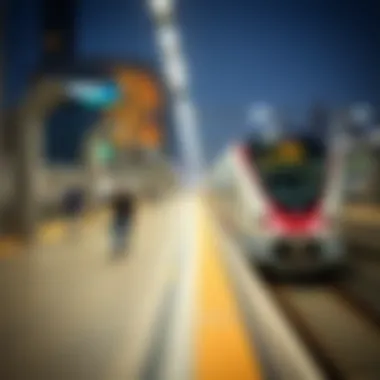Etihad Rail: Impact on Dubai Real Estate Market


Intro
Dubai's dynamic landscape is on the brink of another transformative chapter with the forthcoming launch of Etihad Rail. This ambitious infrastructure project aims to connect the Emirates through a seamless network of rail services, significantly altering the way people navigate and interact with this bustling metropolis. As we inch closer to its opening, it's vital to assess how this rail system might reshape not just urban mobility but also the intricate fabric of Dubai’s real estate market.
The Etihad Rail initiative is not merely about transportation; it encapsulates a vision for the future—a future where accessibility and connectivity are cornerstones of urban life. Investors, homeowners, and stakeholders must remain cognizant of how these developments can influence property values, investment opportunities, and overall market trends.
In this analysis, we will explore various factors that inform the real estate landscape in Dubai as it prepares for the integration of this significant transit method. From current market conditions to future growth predictions and tailored investment strategies, our aim is to deliver a deep and insightful review that empowers our readers to thrive in an evolving environment.
Overview of Etihad Rail
Etihad Rail stands as a pivotal development in the transportation infrastructure of the UAE, particularly impacting the real estate dynamics in Dubai. As the project nears completion, it is essential to understand its significance. This overview will detail the objectives behind the rail system and its anticipated benefits for various sectors, most notably the real estate market.
Definition and Purpose
Etihad Rail is a railway project aimed at connecting major cities across the UAE, transforming how goods and passengers move within the region. The system will cover multiple emirates, serving as a backbone for both freight and passenger transport. It is designed not only to enhance connectivity but also to alleviate traffic congestion on roads, thus playing a crucial role in urban mobility. The rail's introduction will allow for more efficient travel, ultimately leading to increased accessibility for residents and expats alike.
Moreover, the project's purpose extends beyond mere transportation. It is a strategic initiative that aligns with the UAE's broader vision of economic diversification and sustainable development. By promoting the use of public transit, Etihad Rail will contribute to reducing carbon emissions, thereby addressing environmental concerns.
Historical Background
The idea of establishing a rail network in the UAE has been in the making for several years, with discussions dating back to the early 2000s. However, it wasn't until 2009 that Etihad Rail was officially launched as a project. The government recognized the necessity of an integrated transport system to support economic growth and urban expansion. In 2010, construction commenced, setting in motion a comprehensive network expected to span approximately 1,200 kilometers.
Over the years, the project faced several challenges—from securing funding to aligning various stakeholders’ interests. Nonetheless, progress persisted, with technological advancements and strategic partnerships enhancing the viability of the rail system. Major milestones have included the successful completion of key sections of the route, bringing the initial operational segments closer to reality. The excited anticipation surrounding its eventual launch reflects the project’s potential to reshape the urban landscape of Dubai and further beyond.
"The rail system is not just a transport project; it embodies the future of urban living and development in the UAE."
As Dubai prepares for the launch of Etihad Rail, the forthcoming changes are likely to influence real estate trends significantly. Investors and developers need to remain aware of how accessibility via this rail system could transform property values and urban development patterns in the region. With its unique infrastructure, Etihad Rail is set not only to connect cities but also to bridge gaps in the real estate market, offering new opportunities for growth.
Current Status of the Etihad Rail Project
Understanding the current status of the Etihad Rail project is essential for anyone invested in Dubai's booming real estate market. With the announcement of this robust rail system, stakeholders are keenly observing how the project's trajectory will impact property values, urban development, and overall economic health in the region. Successful completion and operation of the rail network could be a game-changer for the city.
Construction Progress
The construction progress of Etihad Rail paints a picture of dynamic development. Spanning a considerable distance across the UAE, the rail network's construction is not just about laying down tracks; it's about connecting communities and boosting economic activity. Major sections have reached various milestones that signify a solid movement towards completion.
As of now, about 70% of the first phase has been completed. This phase primarily focuses on establishing a rail line from Abu Dhabi to Dubai, a route that crucially links these two vibrant cities. Additionally, significant groundwork has been laid in establishing relevant infrastructure such as stations and maintenance facilities, with more than 1,000 kilometers of track already constructed.
Key features of this construction stage include:
- Advanced Engineering Techniques: Utilizing cutting-edge methods to ensure durability and efficiency.
- Use of Local Materials: Maximizing local resources not only boosts the economy but also minimizes environmental impact, making the project more sustainable.
- Job Creation: The project has generated thousands of jobs, offering opportunities in construction, engineering, and various support roles, thereby benefiting local economies.
"With each rail laid, we don't just build transportation; we build a future of connectivity and opportunity."
Projected Completion Date
The anticipated completion date for the Etihad Rail project stands as a crucial point for many investors and homeowners. Originally slated for earlier phases to conclude by 2023, reports indicate a slightly extended timeline due to various logistical challenges. However, the current estimates suggest that the entire first phase could be operational by the end of 2024.
The updated timeline is significant for several reasons:
- Economic Forecasting: With a clear completion date, businesses can make informed decisions regarding investments and expansions.
- Real Estate Development: Understanding when the rail will be operational helps property developers align their projects with transportation access, enhancing the attractiveness of their offerings.
- Government Incentives: Local authorities are expected to introduce incentives for property buyers and developers looking to capitalize on the new rail network, further stimulating market activity.
In summary, the current state of the Etihad Rail project indicates significant progress with sight set on completion. Its influence on the real estate landscape is expected to be profound, reshaping urban development and connectivity in Dubai.
Design and Infrastructure of the Rail System


The design and infrastructure of the Etihad Rail system stand as the backbone of what could reshape not only transportation in the region but also the broader real estate landscape of Dubai. Rail systems are often lauded for their efficiency, but the intricacies that lie within the design and technology harnessed in this project will bear incredible weight in dictating the connectivity, accessibility, and ultimately, value of real estate in the area.
Route and Connectivity
One of the defining characteristics of the Etihad Rail is its extensive route network. Stretching from the bustling cities of Abu Dhabi to the vibrant cultural epicenter of Dubai, it is designed to connect various emirates seamlessly. Consider the narrow streets and traffic-clogged lanes typical around major urban hubs. In stark contrast, an efficient rail system can offer an escape route of sorts, enabling residents and visitors alike to bypass road congestion, hence saving time.
An essential feature of the rail’s route design is the strategic placement of its stations. Destined to serve key areas including business districts and residential neighborhoods, the connectivity offered is bound to shift how people move about their daily lives. Think of it this way: potential homebuyers might prioritize properties located near these stations, essentially inflating their market value. This proximity will likely translate into increased desirability, driving up both rents and sale prices.
Moreover, the integration of additional transit options, such as feeder buses and tram systems, further enhances the network's connectivity. Public transport interlinks play a significant role in attracting real estate investments as they demonstrate a streamlined urban mobility experience. With a comprehensive rail system in place, Dubai could carve its name even deeper onto the global map as a city committed to advanced urban planning and environmentally friendly transport solutions.
Facilities and Technology
Speaking of modernity, the facilities and technology embedded within the Etihad Rail project are top-notch, combining innovation with a vision of sustainability. The stations are designed not only for functionality but also to echo aesthetic considerations, making them more than mere transit points. With plans for features that may include wi-fi lounges, retail areas, and charging stations, the stations will cater to the modern commuter's needs, reflecting a hospitable atmosphere.
The technology aspect is another crucial pillar. Advanced signaling systems coupled with energy-efficient trains ensure that the rail operates seamlessly while minimizing environmental impacts. The technology isn’t solely about making trains run on time; it’s about crafting an entire ecosystem where all connected services perform harmoniously. For instance, automatic ticketing systems and mobile applications that provide real-time updates will enhance user experience significantly.
Furthermore, considerations for the infrastructure's durability are paramount—materials that withstand the harsh desert climate or natural disasters are smart choices. By employing strategies such as solar power and green building materials, Etihad Rail sets a benchmark for future projects in sustainability.
As a result, the facilities and technology incorporated into this rail system are more than details on paper; they represent a shift toward a tech-savvy and eco-conscious urban environment. With the opening of this rail system, investors will likely begin to view real estate adjacent to these hubs as premium based on enhanced access and quality of life that comes with effective public transport solutions.
"The true value of Etihad Rail lies not only in its physical connectivity but also in its potential to foster a more integrated urban life."
In summary, the Design and Infrastructure of Etihad Rail are poised to bring substantial changes not just to transportation but also to Dubai's real estate landscape. Every facet—from the expansive route to advanced facilities—intertwines urban planning with modern technology, potentially reshaping the socio-economic fabric of the region.
Economic Implications of Etihad Rail
The advent of the Etihad Rail project represents a significant shift in the economic landscape of Dubai and its surroundings. It’s not just about laying down tracks; this venture promises to redefine how we think about transport, accessibility, and ultimately, property values in a rapidly developing urban ecosystem. To grasp the full economic implications, it’s critical to dissect its impact on property values, the new business opportunities it will generate, and its role in boosting tourism.
Impact on Property Values
The introduction of the Etihad Rail line is likely to have a cascading effect on property values across various neighborhoods in Dubai. As transportation options become more accessible, areas previously considered remote may suddenly gain attractiveness for both residential and commercial developments.
- Accessibility: Properties within close proximity to rail stations typically see an uptick in demand. This invites not just commuters but also investors looking for capital appreciation.
- Price Stability: The added transportation infrastructure could enhance the market stability, meaning less volatility in property prices, which is a boon for investors.
- Mixed-Use Developments: Areas near rail stations might see a rise in mixed-use developments. These initiatives, integrating living, shopping, and working spaces, are likely to see higher property values because residents prefer convenience.
To illustrate this, consider the neighborhood of Al Quoz, which many argue has been underexplored. With Etihad Rail's expected stations nearby, property values could reflect a sharp increase once the system operations commence.
"Transportation and real estate are intertwined in ways that forge economic landscapes. A city with poor transport links suffers. But, with Etihad Rail's arrival, that could all change for the better."
Business Opportunities
The ripple effect of the Etihad Rail project will create numerous business opportunities, nurturing a more vibrant local economy. It’s not just about real estate; diverse sectors stand to benefit.
- Retail and Services: Stations can become hubs of activity, drawing foot traffic that will benefit local shops, cafes, and service providers. The rise of businesses in these areas could dwarf initial expectations.
- Logistics and Warehousing: The rail line opens avenues for logistics firms, primarily because it will facilitate efficient movement of goods between Emirates. This could make Dubai an even more appealing destination for international businesses.
- Job Creation: As new businesses emerge, job opportunities will abound. Residents could see an uptick in varied employment possibilities ranging from service jobs to managerial roles in burgeoning firms.
As a real-world example, think of the success stories of cities like Milton Keynes in the UK, where improved transport links vastly boosted local economies.
Boosting Tourism
The Etihad Rail isn't solely for residents and commuters; it’s a gateway for tourists who seek more than just a quick jaunt through the city.
- Ease of Travel: As visitors can glide seamlessly between emirates, they’ll likely opt for longer stays. An easier connection to attractions across the region could bring in new visitor demographics.
- Integrated Travel Packages: Travel agencies can craft integrated travel packages, inclusive of rail travel, to encourage exploration of Dubai's surroundings. This strategy not only enhances the tourist experience but also supports local businesses.
- Events and Festivals: The proximity to rail systems can facilitate larger-scale events and festivals, drawing even more visitors. Cultural and entertainment sectors could see an infusion of tourism dollars, which will have a positive downstream effect on local economies.
Integration with Dubai's Urban Planning
The integration of Etihad Rail into Dubai's urban planning framework serves as a pivotal component in shaping the city’s future landscape. City planners and governmental bodies have long recognized that effective public transit not only enhances mobility but also positively influences urban growth. As Dubai continues to evolve, the rail system is set to play a significant role in connecting the city’s diverse neighborhoods and facilitating access to key areas.


Connection to Other Transport Systems
The seamless connectivity offered by Etihad Rail to other transport systems is one of its most noteworthy attributes. By linking with the existing Dubai Metro, Water Transport, and bus services, Etihad Rail is set to create an integrated transportation network that enhances convenience for residents and visitors alike. Commuters can expect smoother transitions between different modes of transport, reducing travel time and congestion on the roads.
For instance, the connections at major stations will feature well-planned interchanges, enabling passengers to switch effortlessly from the rail to buses or metro lines.
Moreover, this interconnected approach not only benefits everyday travelers but also promotes the use of public transport, potentially diminishing greenhouse gas emissions. This aligns with Dubai's vision to become a sustainable, eco-friendly metropolis. The widespread use of interconnected transport systems can alleviate congestion in peak hours and contribute to a cleaner environment, reinforcing the government’s commitment to a greener future.
Influence on Zoning and Development
The impact of Etihad Rail on zoning and urban development should not be underestimated. The rail system has the potential to reshape the allocation of land and the types of developments that occur around its stations. As transportation hubs emerge, they typically become focal points for new developments, including commercial, residential, and mixed-use projects. This is already observable in areas surrounding metro stations, where property values usually see appreciable increases due to improved access.
Environmental Considerations
The Etihad Rail project isn't just about transporting people and goods; it also carries significant weight in terms of environmental considerations. The railway aims to minimize the carbon footprint associated with transportation in the UAE, which is crucial given the rapid urbanization and car dependency witnessed in the region. As cities grow, so does the urgency to find sustainable alternatives that not only serve short-term needs but also safeguard the natural surroundings for future generations.
Sustainability Initiatives
One of the flagships of the Etihad Rail initiative is its commitment to sustainability. This isn't merely a footnote but a fundamental design principle woven into the very fabric of the project. Among the core initiatives:
- Eco-Friendly Materials: The construction phase actively incorporates recyclable materials, thereby reducing waste and the environmental impact of construction practices.
- Energy Efficiency: The systems in place aim to use energy-efficient technologies, effective in minimizing energy consumption levels over time. Solar panels are also considered for powering stations, which could significantly reduce reliance on traditional power sources.
- Wildlife Protection: Careful planning accounts for wildlife corridors, ensuring that local fauna can coexist safely with the infrastructure. This element resonates with environmentalists and local communities alike, who see this as a way to balance progress with biodiversity conservation.
- Water Management: Thoughtful designs include the implementation of rainwater harvesting and greywater recycling systems at railway stations, which helps conserve precious water resources in a region where water scarcity is a pressing concern.
These initiatives align with the UAE's broader goals to diversify energy sources and encourage sustainable practices across various sectors.
Effect on Urban Green Spaces
The development of Etihad Rail is poised to dramatically alter the urban landscape, with a direct correlation to green space management. The implications are extensive:
- Increased Access to Green Areas: Rail stations are strategically situated near parks and recreational spaces. This enhanced access can encourage more residents to engage with these areas, fostering community interactions and promoting wellness activities.
- Urban Renewal: As the railway connects various districts of Dubai, it can trigger urban renewal projects aimed at revitalizing underused or neglected spaces. This often leads to the establishment of new parks or green belts, contributing to better air quality and aesthetic enhancements.
- Reduction of Vehicle Emissions: By providing an efficient alternative to road transportation, the rail project could lead to fewer cars on the road, subsequently improving overall air quality. This is especially crucial in high-traffic areas where pollution levels tend to spike.
- Landscape Design Contributions: The project could lend itself to innovative landscaping designs that include native plants, which require less water and maintenance compared to foreign species. Such practices can contribute positively to the local ecology, supporting native wildlife.
"Greater access to green spaces linked to Etihad Rail may facilitate healthier lifestyles for urban dwellers, blending convenience with environmental mindfulness."
As Etihad Rail gears up for launch, the incorporation of these environmental considerations not only enhances operational efficiency but transforms the perception of public transit into an integral part of a sustainable urban ecosystem.
Challenges Facing the Etihad Rail Project
The Etihad Rail project, a cornerstone of Dubai’s ambition to reshape its transportation landscape, does not come without its hurdles. Understanding these challenges is critical for stakeholders, including investors, residents, and urban planners, who are eager to see how this project aligns with Dubai's growth trajectory. Addressing potential issues now can lead to smoother transitions and enhanced outcomes down the line.
Financial Hurdles
One of the primary concerns surrounding the Etihad Rail project is the looming financial obstacles. Cost overruns, which often plague large-scale infrastructure projects, may threaten timelines and projections. Initial estimates have suggested a budget that might not hold up under the pressures of inflation and changing construction costs. Moreover, securing funding from various sources—whether governmental or private—can be quite the tightrope walk.
Potential Financial Implications:
- Budget Constraints: Each delay or additional expense chips away at profitability for involved parties.
- Funding Sources: Reliance on multiple funding streams can complicate financial flexibility.
"It’s like trying to juggle while riding a unicycle; one miscalculation can lead to a tumble that affects everyone involved.”
Additionally, the potential borrowing needed to bridge budget gaps raises alarms about long-term financial sustainability. Stakeholders must weigh the costs against expected returns, carefully evaluating if the projected increase in property values will sufficiently cushion these financial blows.\n
Logistical Issues
As with any large infrastructure endeavor, the Etihad Rail project must navigate a maze of logistical challenges. From procurement of materials to workforce allocation, logistics plays a pivotal role. For instance, the availability of construction materials can be erratic, especially in a market with high demand. Furthermore, timely delivery schedules, crucial for maintaining momentum, might be hampered by traffic or supply chain disruptions.
Key Logistical Concerns:


- Material Supply: Shortages or delays can halt construction, causing significant project setbacks.
- Workforce Management: Coordinating a skilled workforce amidst shifting project dynamics can lead to inefficiencies.
Ensuring the coordination of various contractors, subcontractors, and suppliers is no small feat. Effective communication and project management are essential to avoid pitfalls, as a misstep could ripple through the entire operation. The interplay of financial and logistical challenges highlights the complexities that stakeholders face as they advocate for this vital project.
Public Perception and Acceptance
Public perception and acceptance of the Etihad Rail project are critical factors that will determine its long-term success and impact on Dubai's real estate landscape. As the rail system promises to reshape the urban mobility experience, understanding how it is received by the community and backed by the government can provide valuable insights for investors and stakeholders. The impact of public sentiment on such projects cannot be underestimated; it can either facilitate smooth implementation or, conversely, lead to significant roadblocks.
Community Feedback
Community feedback is a reflection of how residents perceive the project. It plays an essential role in shaping the implementation of the rail system and its overall effectiveness in meeting public needs. Local residents have varying opinions on what the rail project offers. Some residents are longing for better connectivity, quicker commutes, and the excitement of new amenities along the rail line. Others might be concerned about construction disruptions, changes in neighborhood dynamics, or environmental implications.
The government has initiated forums and surveys to gauge community sentiment regarding the project. This approach not only garners valuable insights but also involves the community in a dialogue about their expectations. For instance, a significant number of surveys indicated a desire for accessibility to key areas like malls, hospitals, and educational institutions through the new rail network. Such feedback shapes the planning process significantly, influencing where stations will be placed and how services are tailored to meet community needs.
“A successful infrastructure project depends heavily on public endorsement and active community participation.”
Many residents express hopes that the Etihad Rail project will not only enhance their daily commute but also keep real estate prices buoyant in surrounding neighborhoods. Feedback collected from residents suggests a growing optimism that the rail will catalyze long-term growth and stability in property values, making the area more attractive for both homeowners and investors alike.
Government Support and Promotion
Government backing is vital in building public confidence and promoting the Etihad Rail project. The UAE government has made substantial investments in the infrastructure, signaling a commitment to seeing it through to completion. This support resonates with the community, often seen as a sign of reliability and security. When local authorities actively promote the benefits of the rail system, it can shift the narrative from skepticism to excitement.
Promotional campaigns, including public meetings, online platforms, and informative pamphlets, emphasize the numerous advantages that the rail system will provide. Stressing reduced travel times, enhanced connectivity, and the positive environmental impact can lead to broader acceptance among the public.
Moreover, the government is committed to addressing community concerns that arise. They often establish channels for residents to voice their worries or suggestions. By providing transparency about the project's goals and timeline, they are able to mitigate fears of disruption and encourage a shared vision for growth.
In summary, public perception and acceptance of the Etihad Rail project hinge on consistent community feedback and robust government support. Successfully navigating these elements will not just facilitate smooth project implementation but will also ensure that the rail system contributes positively to Dubai's real estate landscape, fulfilling the aspirations of residents and investors alike.
Future Developments After Opening
With the anticipated opening of Etihad Rail, a significant juncture is notable not just for the rail itself but for the broader implications on the real estate market in Dubai. This section explores future developments after the launch, delving into crucial aspects that affect the landscape of the city, including expansion plans and the long-term impacts on the region. Understanding these elements is essential for investors and stakeholders, as the development of efficient transport systems has been linked to elevated property values and urban growth.
Expansion Plans
Once the Etihad Rail system is operational, plans for its expansion will likely gain momentum. The railway is designed to connect major cities across the UAE, with a vision that stretches beyond merely facilitating everyday commutes. Future endeavors might include extending existing lines to not only enhance connectivity among urban centers but also push into less accessible areas.
These expansion plans could influence the development of new residential and commercial properties, particularly in areas that currently lack infrastructure. As accessibility improves, property developers will likely consider these zones ripe for investment.
- Potential New Routes: Plans could include routes to Northern Emirates, creating a bigger network encompassing Sharjah, Ajman, and beyond.
- Increased Station Developments: As the network expands, additional stations could emerge in suburban areas, prompting growth in those neighborhoods.
"The pattern of urban development often trails the paths of infrastructure," a local urban planner noted, highlighting the critical relationship between transport and real estate growth.
Long-Term Impact on the Region
In the long run, the impacts of Etihad Rail are projected to be transformative for Dubai and the greater UAE region. The rail system is positioned not merely as a mode of transport but as a catalyst for regional integration and economic growth.
- Economic Hubs: The rail’s integration could lead to the emergence of new economic hubs, pulling investment into areas previously deemed as secondary locations. Land value could rise sharply, leading to renewed interest from commercial entities.
- Urban Spread: With ease of transport, the urban sprawl can be managed more efficiently, possibly alleviating congestion in the central areas of Dubai.
- Population Movement: As the rail system opens up previously untapped regions, a population shift towards new residential projects may occur, thereby altering demographic patterns and housing demand.
In summary, understanding the future developments post-opening of Etihad Rail is pivotal for savvy real estate agents, investors, expatriates, homeowners, and developers. It’s not just about carving out a train line; it’s about setting the stage for Dubai’s urban evolution.
Finale
The anticipated arrival of Etihad Rail marks a pivotal moment for both its users and the developers, promising to reshape the architectural and economic landscape of Dubai. This conclusion encapsulates the multi-faceted elements covered throughout the article, focusing on factors that are not just critical but beneficial. As we look ahead, the rail system's implications for real estate cannot be understated. The proximity to rail stations is likely to become a major selling point for properties.
Recap of Key Points
In the last several sections, we explored several key aspects, including:
- Economic Implications: The boost in property values is poised to transform neighborhoods and encourage investment. With new business opportunities on the horizon, the potential for increased rental yields cannot be ignored.
- Integration with Urban Planning: The seamless connection to existing transport modes adds another layer of convenience, solidifying Etihad Rail’s role in urban mobility.
- Environmental Factors: Sustainability initiatives linked to the rail project indicate a commitment to greener urban development, enhancing livability and attracting environmentally-conscious buyers.
- Community Response: Public sentiment seems generally favorable, with positive feedback on government involvement playing a significant role in the project's approval and support.











